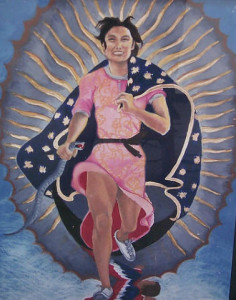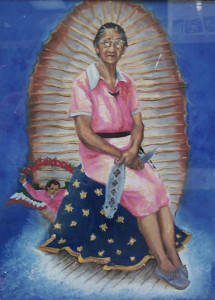In my first and second installment of the examination of the Virgin of Guadalupe, I examined where she came from and how her image became a symbol not only for religious sanctuaries but also for the rejuvenation of the Chicano people during their Human Rights Movement liberation in the 1960s. I wanted to end my research on showcasing how the Virgin became a pivotal symbol for Chicanas as well as showing different art interpretations of the originally Virgen into more contemporary depictions of feminism. Chicana Feminism is defined as “an ideology based on the rejection of the traditional ‘household’ role of a Mexican-American woman. In challenges the stereotypes of women across the lines of gender, ethnicity, class, race, and sexuality. Most importantly, it serves as a middle ground between the Chicano Movement and the Women’s Liberation Movement” (What is the Chicana Movement?)
The Chicana Feminist Movement began to gain momentum with the 1969 Chicano Youth Liberation Conference which took place in Denver, Colorado. The actually term “Chicano/a” was adopted for national identity use and the goals and objectives were laid out not only for the male population but for the women. Goals of equality as well as matters of sexism were addressed and resulted in more movements and protests outside the conference’s limitations.
Much like how we discussed how the Virgin’s symbol has evolved representing two sides of the coin, traditionally she was represented as a loving mother of peace and harmony but especially one of feminine passivity. The Chicana Feminist Movement transformed into from the Protector, a role a man typically embodies, and gives her the hybrid representation of “tradition and liberation”. She embodies the struggle women face in the Chicana Movement behind men and the culture they live in, much like the Indians seeking indignities outside the subjectivity of the conquering Spanish invaders:
“When Chicana feminist artists, cultural workers, and intellectuals focus on Guadalupe’s strength and reconstitute her from the traditional passive being to an active subject, they are reinscribing her beyond patriarchal meanings” (Elenas 106).
Yolanda M. Lopez is a scholar but also a combination of activist through artistic expression. Lopez created the Guadalupe Series which caused controversy because of her work combining the traditional figure of the Virgin mixed with Mexican women of everyday Modern life. Lopez commented on her choices:
“I originally did the Virgin de Guadalupe series when I was looking at media. I wanted to look at the images that we have of the Virgin–she was essentially the most ubiquitous female Latina. What was its meaning? So, I did the first one of myself running.
Then I did the image of my mother [as the Virgen] who was working at the Navel Training Center at a sewing machine, so I wanted to show her as a working woman. This is one of the problems with the Virgen de Guadalupe being so ubiquitous, there is no real imagery of Latinas at the work that we do.
The other one was that of my grandmother. The Virgen de Guadalupe is always this beautiful, young thing. Yet there is no depiction of her as an older woman. I was conscious about this and so that‘s why I did my grandmother as an older woman. I see the Virgen de Guadalupe as being the great Aztec goddess and I think that’s one of the reasons why she has such a strong, indefinable hold on Mexicans and women in general. Its more primordial. I think the great Aztec goddess, Cuatlique, depicts the primal forces in nature: life, death and rebirth” (Lopez).
Pinterest Page of Varying Representations of the Virgen de Guadalupe
Works Cited:
N. a. “What is the Chicana Movement?”. Exploring the Chicana Feminist Movement. N.d. Web. 29 May 2014. <http://www.umich.edu/~ac213/student_projects07/latfem/latfem/whatisit.html>.
Elenas, Alejandra C. Transforming Borders: Chicano/a Popular Culture and Pedagogy. New York: Lexington Books, 2010. Print.
Lopez, Yolanda. “Bareclaimingthelatinatag: Yolanda M. Lopez: The Virgen de Guadalupe”. Mikkipedia. 15 Dec 2012. Web. 29 May 2014. <http://mikkipedia.net/?p=6172>
Photos:
http://mikkipedia.net/?p=6172
http://chicanas.com/about.htm
http://kookitasthoughts.blogspot.com/p/virgin-of-guadalupe.html






